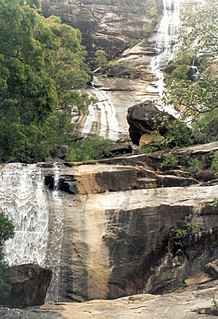
Bowling Green Bay is a national park in the City of Townsville and Shire of Burdekin, Queensland, Australia, 1,103 km northwest of Brisbane, and 28 km south of Townsville and 59 km north of Ayr. It is a Ramsar Convention listed site. The park protects diverse range of habitats including the rugged, forested landscape surrounding Mount Elliot and Saddle Mountain as well as coastal estuaries between Cape Cleveland and Cape Bowling Green.

Cape Hillsborough is a national park in Mackay Region, Queensland, Australia.

The Daintree rainforest is a national park in Far North Queensland, Australia, 1,757 km (1,092 mi) northwest of Brisbane and 100 km (62 mi) northwest of Cairns. It was founded in 1981 and is part of the Wet Tropics of Queensland. In 1988 it became a World Heritage Site. The park consists of two sections, with a settled agricultural area between them which includes the towns of Mossman and Daintree Village.

Cape York Peninsula is a large peninsula located in Far North Queensland, Australia. It is the largest unspoiled wilderness in northern Australia. The land is mostly flat and about half of the area is used for grazing cattle. The relatively undisturbed eucalyptus-wooded savannahs, tropical rainforests and other types of habitat are now recognised and preserved for their global environmental significance. Although much of the peninsula remains pristine, with a diverse repertoire of endemic flora and fauna, some of its wildlife may be threatened by industry and overgrazing as well as introduced species and weeds.

The Mitchell River is a river located in Far North Queensland, Australia. The river rises on the Atherton Tableland about 50 kilometres (31 mi) northwest of Cairns and flows about 750 kilometres (470 mi) northwest across Cape York Peninsula from Mareeba to the Gulf of Carpentaria.

Laura is a rural town and locality in the Shire of Cook, Queensland, Australia. In the 2016 census the locality of Laura had a population of 228 people.

Cape Tribulation is a headland and coastal locality in the Shire of Douglas in northern Queensland, Australia. In the 2016 census, Cape Tribulation had a population of 118 people.

Mapoon is a coastal town in the Aboriginal Shire of Mapoon and a locality split between the Aboriginal Shire of Mapoon and the Shire of Cook in Queensland, Australia. In the 2016 census, Mapoon had a population of 317 people.

The Shire of Cook is a local government area in Far North Queensland, Australia. The Shire covers most of the eastern and central parts of Cape York Peninsula, the most northerly section of the Australian mainland.

Cape Melville is a headland on the eastern coast of the Cape York Peninsula in Australia. To its west lies Princess Charlotte Bay. It is part of the Cape Melville National Park. Cape Melville was named Stoney Cape in 1815 by Lieutenant Charles Jeffreys on the HM Kangaroo but later renamed by him as Cape Melville

The McIlwraith Range is a rugged, dissected granite plateau on the Cape York Peninsula of Far North Queensland, Australia. Part of the Great Dividing Range, the McIlwraith Range covers about 3,000 square kilometres (1,200 sq mi) and lies about 15 kilometres (9.3 mi) east of the town of Coen, and 550 kilometres (340 mi) north of Cairns. The Archer and Stewart Rivers rise in the range, with the Archer draining the range's western slopes into the Gulf of Carpentaria and the Stewart draining east into the Coral Sea. The range receives an annual rainfall of about 1,500 millimetres (59 in).
The Ducie River is a river located on the Cape York Peninsula in Far North Queensland, Australia.

Cooktown is a coastal town and locality in the Shire of Cook, Queensland, Australia. Cooktown is at the mouth of the Endeavour River, on Cape York Peninsula in Far North Queensland where James Cook beached his ship, the Endeavour, for repairs in 1770. Both the town and Mount Cook which rises up behind the town were named after James Cook.
The Cape Melville shadeskink is a species of lizards from the Cape York Peninsula of Queensland, Australia, described in 2013. It was one of three vertebrates discovered by scientists from James Cook University and National Geographic in an area of mountain rainforest in North Queensland. The lizards are active by day, running and jumping through the mossy boulder fields of Northern Queensland.
Alwal National Park is a national park in the Shire of Cook on the Cape York Peninsula in Far North Queensland, Australia.
The Jeannie River is a river located in Far North Queensland, Australia.

The Mossman River is a river located in the Cape York Peninsula of Far North Queensland, Australia.
Iron Range is a coastal locality in the Shire of Cook, Queensland, Australia. In the 2016 census, Iron Range had a population of 14 people. The town of Portland Road is on a north-east headland in the locality.
Starcke is a coastal locality in the Shire of Cook, Queensland, Australia. In the 2016 census Starcke had a population of 3 people.

James Peter Stanton is an Australian landscape ecologist, fire ecologist, botanist and biogeographer who individually conducted systematic environmental resource surveys throughout Queensland whilst working for the National Parks department of Forestry (Qld.) from 1967–1974. He carried out his assessments in a range of dissimilar landscapes leading to the identification and protection of many critically threatened ecosystems across the state during a period of rapid and widespread land development under the Joh Bjelke-Petersen government. For this work he became the first Australian to receive the IUCN Fred M. Packard Award in 1982.












